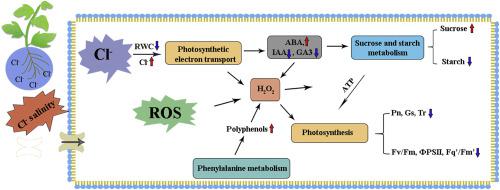Plant Physiology and Biochemistry ( IF 6.1 ) Pub Date : 2020-05-22 , DOI: 10.1016/j.plaphy.2020.05.021 Lin Wang 1 , Jia-Yang Xu 2 , Wei Jia 1 , Zheng Chen 1 , Zi-Cheng Xu 1

|
Chloride (Cl−) is a micronutrient and a beneficial ion for plant growth, but excess Cl− easily leads to Cl− salinity. As a species sensitive to Cl−, tobacco experiences serious damage when encountering excessive Cl−. However, the molecular mechanism by which excess Cl− delays plant growth and development remain largely unknown. In this study, physiological, biochemical and genetic responses were determined in tobacco plants exposed to 12 h, 24 h and 48 h of Cl− salinity. Compared with the control, Cl− salinity increased the content of Cl− and decreased the relative water content (RWC) in tobacco, which severely limited the photosynthetic capacity and reduced photosynthetic products, resulting in decreased levels of auxin (IAA) and gibberellin (GA3). In addition, tobacco increased the content of starch, total phenol and increased phenylalanine ammonia-lyase (PAL) activity in response to Cl− salinity. Multi-omics results revealed that a total of 15,445 genes and 1983 proteins were differentially abundant in response to Cl− salinity. Two metabolic pathways, phenylalanine metabolism and starch and sucrose metabolism, were specifically enriched in the transcriptomic and proteomic data, respectively. In addition, our conjoint analysis of RNA-Seq and proteomics data revealed that 734 differentially abundant genes/proteins were enriched mainly in plant hormone signal transduction, photosynthesis and photosynthesis-antenna protein pathways. Our work presented here not only provides new insights into the molecular response of tobacco to Cl− salinity but also offers important guidance for the improvement of Cl− sensitive crops.
中文翻译:

氯敏感植物中的氯盐度:重点关注烟草中的光合作用、激素合成和转导。
氯化物(Cl - )是一种微量营养素,也是对植物生长有益的离子,但过量的Cl -容易导致Cl -盐分。烟草作为对Cl -敏感的物种,当Cl -过量时,会受到严重损害。然而,过量的 Cl -延迟植物生长和发育的分子机制仍然很大程度上未知。在这项研究中,测定了暴露于Cl-盐度 12 小时、24 小时和 48 小时的烟草植物的生理、生化和遗传反应。与对照相比, Cl−盐度增加了烟草中Cl−含量,降低了相对含水量(RWC),严重限制了烟草的光合能力,光合产物减少,导致生长素(IAA)和赤霉素(GA3)水平下降。 )。此外,烟草增加了淀粉、总酚的含量,并增加了响应Cl-盐度的苯丙氨酸解氨酶 (PAL) 活性。多组学结果显示,共有 15,445 个基因和 1983 个蛋白质对Cl-盐度的响应存在差异丰度。两种代谢途径,苯丙氨酸代谢以及淀粉和蔗糖代谢,分别在转录组和蛋白质组数据中特别丰富。此外,我们对RNA-Seq和蛋白质组学数据的联合分析显示,734个差异丰富的基因/蛋白质主要富集在植物激素信号转导、光合作用和光合作用-天线蛋白途径中。 我们在此介绍的工作不仅为烟草对 Cl -盐度的分子响应提供了新的见解,而且还为 Cl -敏感作物的改良提供了重要指导。











































 京公网安备 11010802027423号
京公网安备 11010802027423号